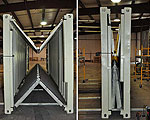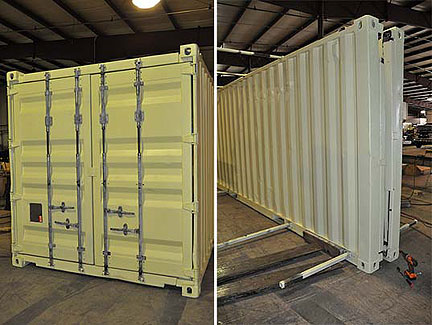Collapsible Shipping Containers
 May-04-11
Collapsible shipping containers can be folded when empty, saving space as well as the fuel required to ship the empty boxes.
May-04-11
Collapsible shipping containers can be folded when empty, saving space as well as the fuel required to ship the empty boxes.The containers, designed by Staxxon, can be folded vertically, reducing their width down to 1/5 of the original dimensions. Being able to reduce the size of the empty containers will drastically cut down on the amount of backhaul ocean voyages each year, which will reduce emissions. The foldable containers will enable companies to buy fewer units, which will save materials and cut down on waste.

More Info about this Invention:
[INHABITAT.COM][STAXXON]
Add Comment
Have you started marketing the product?
Posted by RAJA ZULKIFLI RAJA AHMAD on May 19, 2011
How much it cost?
Posted by Ilya Chervony on September 22, 2011
I am interested in knowing how much this containers costs and the advantage of acquiring them?
Posted by Olehile Thataone on January 10, 2012
Has the prototype been load, wind and water tested at a certified Lloyds / Veritas ISO testing facility and gained full certification. Having 'been there, done that', I am very aware of this need before commercialisation. Vast amounts of capital has been expended by many companies over the years attempting to provide a solution to the shipping of air, but the rigidity of structure against racking requirements, load testing and other requirements to gain that critical certification has confounded most attempts to my knowledge. Is this product going to get through? If it can and does, it will most certainly make a valuable contribution to the world of logistics cost containment and energy reduction. Good luck, it looks great.
Posted by Steve Muir on May 27, 2012
Apologies for not responding to the earlier comments.
1. We will commence field tests and trials during 2H/2012. This means we will make sure the Staxxon design can withstand the all the usual forces, weather and water that are a reality for shipping containers. We will also be testing a system for high speed folding/nesting and working with third parties on freight booking/terminal workflow integration. We have planned 18-24 months of tests, non-commercial trials (simulated cargo), commercial trials (customer cargo), folding/nesting system integration and business use case validation.
2. The incremental manufacturing cost for the design is estimated at 130% of the cost of a standard dry container. E.g. if the manufacturing cost of a 20' standard dry container is $3,000 USD, the manufacturing cost with the Staxxon technology is forecast at $3,900. For container fleet owners/operators, carriers (ocean, rail, truck) and terminal operators (marine/inland), there are various cost saving and efficiency advantages that result from reducing the number of moves (or lifts) of empty containers. E.g., instead of 5 trucks/drivers with 5 chassis delivering 5 empty containers to the terminal gate, only 1 truck/driver and chassis is required to deliver 5 empty containers. The 100% ROI on the total cost of ownership for a container with the Staxxon technology is forecast at 24-30 months, including the incremental labor costs to fold/nest, incremental M&R costs and actual or imputed financing/costs of capital.
3. The 20' design was issued a CSC Certificate in April, 2012. The CSC Certificate Number is USA/MC/101/12. The BIC code for Staxxon test/trial containers is STXU. The Max Gross Weight, Gross Interior Volume, Max Payload, Stacking, Transverse Racking and Floor Strength ratings meet or exceed the typical ratings for 20' standard dry containers. We have a roadmap to increase the Payload rating, reduce the empty weight and reduce the manufacturing cost. Further CSC testing is scheduled for later this year that may increase the Payload/MGW ratings. If you want the CSC rating details:
http://staxxon.com/resources/press-kit/
4. The Staxxon design is implemented using globally available steel container "kits" from the leading container manufacturers and wholesalers. Less than 5% of the parts are proprietary. The assembly and repair methods and associated labor skills are common to all manufacturers, M&R depots and M&R agents. The top design objectives were to retain the structural integrity of an ISO/IMO steel container and use existing workflow at terminals, ports and distribution centers. The left-to-right variable nesting feature means that 2,3,4 or 5 containers can be nested to accomodate terminal or depot inventory and destination workflow.
5. Staxxon's business model is licensing, not manufacturing. Customers (container fleet owners/operators) license the technology (patents, CAD files, bill of materials, materials sourcing options, certification/inspection/training.) Customers use their existing trusted manufacturers and M&R agents to assemble and service the containers with the Staxxon technology. The business use case is built around reducing the number of moves/lifts associated with empty containers and the associated cost savings. There may also be arrival/departure/scheduling benefits to carriers from reducing the time required to load/unload/stow empty containers. In certain markets, reducing the ship or rail space or slots occupied by empty containers may open up slots to laden (revenue-producing) containers.
More information available at http://staxxon.com
Posted by Tom Stitt on May 28, 2012
I have a client interested in discussing the product. please contact 732-266-5188
Posted by Jill Doran on March 1, 2013
Quote Specifics- Size, Acc, Cost- Jill Doran (PE ADVISORS) 732-266-5188
Posted by Jill Doran on January 11, 2016
fields are required.
Comments
Have you started marketing the product?
Posted by RAJA ZULKIFLI RAJA AHMAD on May 19, 2011
How much it cost?
Posted by Ilya Chervony on September 22, 2011
I am interested in knowing how much this containers costs and the advantage of acquiring them?
Posted by Olehile Thataone on January 10, 2012
Has the prototype been load, wind and water tested at a certified Lloyds / Veritas ISO testing facility and gained full certification. Having 'been there, done that', I am very aware of this need before commercialisation. Vast amounts of capital has been expended by many companies over the years attempting to provide a solution to the shipping of air, but the rigidity of structure against racking requirements, load testing and other requirements to gain that critical certification has confounded most attempts to my knowledge. Is this product going to get through? If it can and does, it will most certainly make a valuable contribution to the world of logistics cost containment and energy reduction. Good luck, it looks great.
Posted by Steve Muir on May 27, 2012
Apologies for not responding to the earlier comments.
1. We will commence field tests and trials during 2H/2012. This means we will make sure the Staxxon design can withstand the all the usual forces, weather and water that are a reality for shipping containers. We will also be testing a system for high speed folding/nesting and working with third parties on freight booking/terminal workflow integration. We have planned 18-24 months of tests, non-commercial trials (simulated cargo), commercial trials (customer cargo), folding/nesting system integration and business use case validation.
2. The incremental manufacturing cost for the design is estimated at 130% of the cost of a standard dry container. E.g. if the manufacturing cost of a 20' standard dry container is $3,000 USD, the manufacturing cost with the Staxxon technology is forecast at $3,900. For container fleet owners/operators, carriers (ocean, rail, truck) and terminal operators (marine/inland), there are various cost saving and efficiency advantages that result from reducing the number of moves (or lifts) of empty containers. E.g., instead of 5 trucks/drivers with 5 chassis delivering 5 empty containers to the terminal gate, only 1 truck/driver and chassis is required to deliver 5 empty containers. The 100% ROI on the total cost of ownership for a container with the Staxxon technology is forecast at 24-30 months, including the incremental labor costs to fold/nest, incremental M&R costs and actual or imputed financing/costs of capital.
3. The 20' design was issued a CSC Certificate in April, 2012. The CSC Certificate Number is USA/MC/101/12. The BIC code for Staxxon test/trial containers is STXU. The Max Gross Weight, Gross Interior Volume, Max Payload, Stacking, Transverse Racking and Floor Strength ratings meet or exceed the typical ratings for 20' standard dry containers. We have a roadmap to increase the Payload rating, reduce the empty weight and reduce the manufacturing cost. Further CSC testing is scheduled for later this year that may increase the Payload/MGW ratings. If you want the CSC rating details:
http://staxxon.com/resources/press-kit/
4. The Staxxon design is implemented using globally available steel container "kits" from the leading container manufacturers and wholesalers. Less than 5% of the parts are proprietary. The assembly and repair methods and associated labor skills are common to all manufacturers, M&R depots and M&R agents. The top design objectives were to retain the structural integrity of an ISO/IMO steel container and use existing workflow at terminals, ports and distribution centers. The left-to-right variable nesting feature means that 2,3,4 or 5 containers can be nested to accomodate terminal or depot inventory and destination workflow.
5. Staxxon's business model is licensing, not manufacturing. Customers (container fleet owners/operators) license the technology (patents, CAD files, bill of materials, materials sourcing options, certification/inspection/training.) Customers use their existing trusted manufacturers and M&R agents to assemble and service the containers with the Staxxon technology. The business use case is built around reducing the number of moves/lifts associated with empty containers and the associated cost savings. There may also be arrival/departure/scheduling benefits to carriers from reducing the time required to load/unload/stow empty containers. In certain markets, reducing the ship or rail space or slots occupied by empty containers may open up slots to laden (revenue-producing) containers.
More information available at http://staxxon.com
Posted by Tom Stitt on May 28, 2012
I have a client interested in discussing the product. please contact 732-266-5188
Posted by Jill Doran on March 1, 2013
Quote Specifics- Size, Acc, Cost- Jill Doran (PE ADVISORS) 732-266-5188
Posted by Jill Doran on January 11, 2016
Add your Comment:
[LOGIN FIRST] if you're already a member.fields are required.

Show 7 Comments